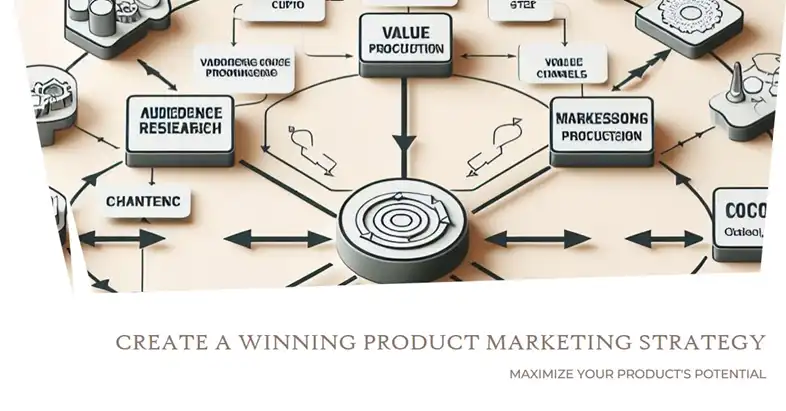A product marketing framework is a structured approach that guides businesses through effectively planning, executing, and optimizing marketing efforts for a product. It serves as a comprehensive blueprint encompassing market research, defining product strategy, building the brand, developing the marketing plan, executing the launch, and measuring results.
The key components of an effective product marketing framework include in-depth market and customer analysis, positioning and differentiation, brand identity and messaging, integrated marketing mix tactics, strategic launch planning, and continuous optimization through data-driven insights. Having a well-defined framework ensures marketing activities align with objectives, enable informed decisions, and focus efforts on delivering customer value.
Here’s a 5-step product marketing framework that can take your product to the next level.

Step 1: Know the Market and Customers

Market Research and Analysis
The first step in any successful product marketing framework is to conduct thorough market research and analysis. This involves gathering and analyzing data on the:
- Target industry
- Competitors
- Market trends
- Regulatory environment
- Economic factors
Marketers should leverage various research methods, including primary research (surveys, focus groups, interviews) and secondary research (industry reports, market studies, and public data sources).
Customer Segmentation and Personas
After gaining a deep understanding of the market, the next step is to segment the target audience into distinct groups based on shared characteristics, behaviors, and needs. This process involves creating detailed customer personas that represent the different types of customers the product aims to serve.
Each persona should include demographic information, psychographic traits, pain points, goals, and buying behaviors. By understanding these personas, marketers can tailor their messaging, positioning, and marketing tactics to resonate with each segment effectively.
Identifying Customer Needs and Pain Points
Building on customer segmentation and personas, marketers should delve deeper into the specific needs, challenges, and pain points that the target customers face. This insight is critical for developing a product and marketing strategy that addresses real customer problems and offers tangible value.
Techniques such as customer interviews, surveys, and user experience (UX) research can provide valuable insights into customer needs and help prioritize product features and benefits based on their importance to the target audience.
Step 2: Establish the Product Strategy

Product Positioning and Differentiation
With a solid understanding of the market and customers, the next step is to define the product’s positioning and differentiation strategy. Positioning involves determining
- Positioning: How the product should be perceived in relation to competitors
- Differentiation: Unique features, benefits, and value propositions
Effective positioning and differentiation help establish a clear and compelling value proposition that resonates with customers and guides all subsequent marketing efforts.
Unique Selling Proposition (USP)
Building on positioning and differentiation, marketers should develop a concise and compelling unique selling proposition (USP) that communicates the product’s core value and competitive advantage. The USP should be a clear, simple statement that highlights the primary benefit or unique feature that addresses a specific customer need or pain point.
Feature Prioritization and Roadmap
Once the product’s positioning, differentiation, and USP are established, the next step is to prioritize the features and capabilities that align with the overall strategy. This involves creating a product roadmap that outlines the planned development and release of features, enhancements, and updates over time. The roadmap should be guided by customer needs, market trends, and the product’s unique value proposition.
Step 3: Build the Brand

Brand Identity and Messaging
With a solid product strategy in place, the next step is to build a strong brand identity that supports the overall marketing efforts. The brand identity contains the follwoing:
- Visual elements: Logo, color palette, typography, imagery
- Messaging: Tagline, brand story, value proposition
Effective brand identity and messaging should align with the product’s positioning, differentiation, and USP, and resonate with the target audience’s values and preferences.
Brand Personality and Tone
In addition to the visual and verbal elements, a strong brand should also have a distinct personality and tone that guides all communication and interactions with customers. Brand personality refers to the human-like characteristics and traits that the brand embodies (e.g., friendly, innovative, trustworthy), while brand tone refers to the style and manner in which the brand communicates (e.g., casual, professional, witty).
Brand Awareness and Recognition
With a strong brand identity and personality in place, the focus shifts to building brand awareness and recognition within the target market. This involves implementing tactics such as content marketing, social media marketing, advertising, public relations, and influencer partnerships to increase the brand’s visibility and reach.
Step 4: Develop the Marketing Plan

Marketing Mix (4Ps: Product, Price, Place, Promotion)
The marketing plan outlines the specific tactics and strategies that will be employed to promote the product and achieve the desired marketing objectives. The traditional marketing mix, also known as the 4Ps (Product, Price, Place, Promotion), provides a framework for developing a comprehensive marketing plan:
- Product: Features, benefits, packaging, and branding
- Price: Pricing models, levels, and pricing tactics
- Place: Distribution channels and accessibility
- Promotion: Marketing tactics and channels
Marketing Channels and Tactics
Within the marketing mix, the promotion element requires the most detailed planning and execution. Common marketing channels include
- Digital: Websites, social media, email, and search engines
- Traditional: Print, television, and radio
- Experiential: Events, trade shows
- Partner marketing: Co-marketing, affiliate programs
Content Marketing, and Lead Generation
Content marketing and lead generation are critical components of the marketing plan, as they help to attract, nurture, and convert potential customers into actual buyers. Content marketing involves creating and distributing valuable, relevant, and consistent content (e.g., blog posts, whitepapers, videos, webinars) to attract and engage the target audience.
Lead generation tactics include creating opportunities for potential customers to express interest in the product or service, such as through gated content, webinar registrations, or contact forms. Once leads are captured, they can be nurtured through targeted content and automated email campaigns to convert them into customers.
Step 5: Execute the Launch Plan

Product Launch Strategy
With the marketing plan in place, the focus shifts to executing a well-coordinated product launch strategy. This involves determining the optimal timing, sequencing, and coordination of various pre-launch and launch activities to maximize impact and generate buzz around the product’s release. Factors to consider include:
- Market readiness
- Competitive landscape
- Seasonality
- Internal resource availability
Pre-Launch Activities
Pre-launch activities are designed to build anticipation and generate interest among the target audience before the product is officially released. These may include:
- Teasers and sneak peeks: Sharing glimpses or hints about the upcoming product through social media, email campaigns, or other channels to pique curiosity and excitement.
- Beta testing and early access: Offering a select group of customers or influencers early access to the product for testing, feedback, and generating word-of-mouth buzz.
- Seeding content and influencer outreach: Collaborating with industry influencers, bloggers, and media outlets to share pre-launch content, product previews, or exclusive interviews to generate awareness and credibility.
Launch Activities
Once the pre-launch activities have built sufficient momentum, the focus shifts to executing the official product launch. This may involve:
- Product announcements: Coordinated announcements and press releases shared across various channels (website, social media, email, press) to formally introduce the product to the market.
- Launch events: Hosting virtual or in-person events, such as webinars, live streams, or physical product launches, to showcase the product, share details, and engage with the target audience.
- Promotions and offers: Offering various benefits for early adopters.
How to Measure and Optimize Your Product Marketing Framework?
Key Performance Indicators (KPIs)
Throughout the product marketing process, it’s crucial to establish clear key performance indicators (KPIs) that align with the overall business objectives and marketing goals. KPIs provide a quantifiable way to measure the success and effectiveness of marketing efforts. Common KPIs in product marketing include:
- Website traffic
- Lead generation
- Conversion rates
- Customer acquisition costs
- Customer lifetime value
- Customer satisfaction/net promoter scores
Product Analytics and User Feedback
In addition to tracking KPIs, product marketers should leverage product analytics and user feedback to gain deeper insights into how customers interact with and perceive the product. Product analytics tools can provide valuable data on feature usage, user behavior, and performance metrics, while user feedback can provide qualitative insights into customer satisfaction, pain points, and areas for improvement.
Continuous Improvement and Iteration
Based on the data and insights gathered from KPIs, product analytics, and user feedback, product marketers should continuously evaluate and optimize their marketing strategies, tactics, and messaging. This iterative approach involves testing and refining different approaches, experimenting with new channels and tactics, and making data-driven decisions to improve the effectiveness of the marketing efforts over time.
Continuous optimization ensures that the product marketing framework remains relevant, adaptive, and aligned with evolving customer needs and market dynamics.
Summary
In summary, a comprehensive product marketing framework serves as a structured approach that guides businesses through the entire marketing process, from understanding the market and customers to defining the product strategy, building the brand, developing the marketing plan, executing the launch, and measuring and optimizing the results.
Remember to:
- Embrace a customer-centric mindset
- Continuously seek feedback and insights
- Adapt and iterate based on data and changing market conditions
- Foster collaboration across cross-functional teams
By following this framework, product marketers can ensure that their efforts are aligned, data-driven, and focused on delivering value to customers and achieving business objectives.

